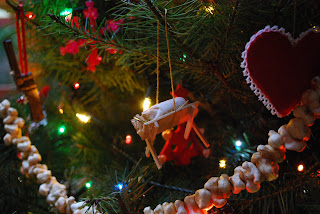O Tannenbaum, O Tannenbaum
(O fir tree, o fir tree)
Wie treu sind deine blatter.
(How loyal are your leaves)
Du grunst nicht nur zur sommerzeit
(You're green not only in the summertime)
Nein auch im Winter, wenn es schneit.
(No, also in winter when it snows)
As the time approaches to once again put up our Christmas tree, we are again having the conversation about whether or not to buy an artificial one. Oh I know, the artificial ones are easier with far less bother and mess. Take them out of the box, straighten out the branches a bit, and they're ready to go. But to me, nothing replaces the color, texture, and heavenly scent of a real tree.
By legend, Saint Boniface, a 7th century monk from England, used the triangular shape of a fir tree as a symbol to teach Germans about the Holy Trinity. Those he converted revered the fir tree as a religious symbol, thus began the association between the fir tree and Christmas. Late in the Middle Ages, Germans and Scandinavians placed evergreen trees in their homes or outside their doors to show their hope in the forthcoming spring. In the 1500s/1600s, historical records in France, Switzerland, and Germany describe trees decorated with apples, cheese, dates, nuts, paper flowers, cakes, tinsel, and sugar hanging from the branches. Legend even has it that Martin Luther decorated a small fir tree with candles to teach his children how the trees in the forest shimmered with snow on a dark night. He dedicated the tree in honor of Christ's birth. The modern-day Christmas tree evolved from these early German traditions.
The history of the Christmas tree in the U.S. dates back to the time of George Washington and his defeat of the German Hessians in the year 1776. The war was during the Christmas season, which for the Germans was a time for food, songs, and decorated trees. Preoccupied with their celebrations, the Hessians became easy prey for Mr. Washington. After the war in 1776, many Germans stayed in the United States, introduced the Christmas tree, and shared their traditions.
Even then, there were differences of opinion. Many early Americans thought the tree should not be displayed at Christmas because it had been pronounced a pagan symbol. The New England Puritans' governor, William Bradford, worked to put an end to the “heathen tradition” of decorated trees and tried to penalize any such display. There's still nothing new under the sun...
In today's world, there are other considerations: How much fossil fuel does it take to produce, handle, and ship all those artificial trees half-way around the world? What happens to them when they finally wear out or are no longer wanted? How many local tree farmers could be helped to put food on their family's table if we all would just "buy local"? What's the experience of finding and cutting one of God's lovely creations really worth?
No, I'm sorry - I still prefer the REAL thing.
For to us a child is born,
to us a son is given,
and the government will be on his shoulders.
And he will be called
Wonderful Counselor, Mighty God,
Everlasting Father, Prince of Peace.
Isaiah 9:6






No comments:
Post a Comment